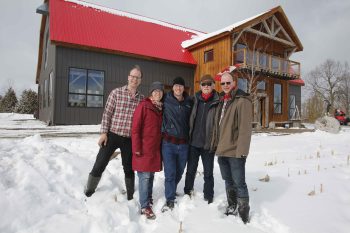August 18, 2009
Cherisse Diaram, second-year Mineral Engineering student, and VP Habitat, Eyes Of Hope, took part in U of T’s Engineering Habitat Campaign earlier this month. Below is her account of the experience.
As an undergraduate engineering student, you have the opportunity to learn, experience and accomplish a great deal, however, there is a limit of what can be learnt in a lecture room.
Habitat for Humanity is a charity that builds homes for low-income families and one of the few projects that continues where tutorials end. At the build events, you can meet all sorts of people, gain practical construction experience and exercise your problem solving skills. In addition, you develop as a leader while making a valuable contribution to the community by building homes for families who really need them.
The objective of the University of Toronto Engineering Habitat Campaign is to bring faculty, staff, students and alumni together to sponsor and build a Habitat for Humanity home. The Campaign is a collaboration between Leaders of Tomorrow – CIV, Eyes of Hope and a number of other groups. To date, the Campaign has sent 193 people to builds and raised over $8,000!
Volunteers who participated in build events at the Hainford Build Site come from many walks of life. The University of Toronto was represented by students from many disciplines and all years, different faculties and departments, as well as professors, administrative staff and alumni. There are few other opportunities for a first-year student and a professor to work side-by-side in a casual setting. This chance promotes a sense of community within the Faculty.
In addition to the group from U of T, it was possible to meet business people, construction workers, and other volunteers from various backgrounds. Many of the future homeowners also participate in the build events. In addition to providing a networking opportunity, this gives participants the opportunity to interact with the people they are helping and develop a deeper understanding of what they have become a part of.
A point to note is that construction continues as scheduled regardless of the weather. When you arrive at a build site, the first thing to do is sign in and gather your safety equipment. All crews assemble in one of the few empty spaces on the Build Site for safety instructions and announcements. Each crew is assigned tasks for the day before they set off to work – safety first! In July, the U of T crews learned how to build safety railings, erect upper-level exterior walls and install interior walls.
When you buy a new bed frame, if it seems like an insurmountable task to assemble it even when supplied with the instruction booklet and set of miniature tools, assembling a house is a lot more difficult. You are really forced to think when you are faced with the task of moving 14-foot wooden beams from one end of the bustling build site to the other. It is also a challenge to assemble scaffolding two stories high in a space barely bigger than the scaffolding frame itself. Your first- or second-year calculus courses cannot help much in those situations; you need to stop, evaluate, and act. This is a chance to develop problem-solving skills that are essential for success.
Participation in Habitat for Humanity and other similar initiatives not only serves to equip you with life’s necessary skills, they give you a chance to improve the lives of families in your community.



